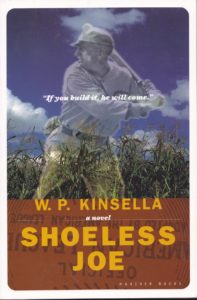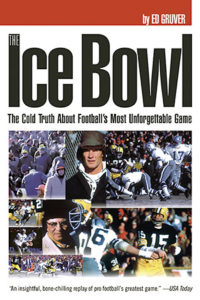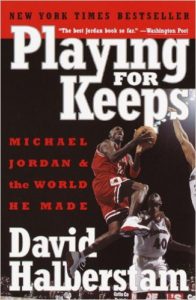 Sports books don’t come anywhere close to romance novels in their share of the publishing market, but there are still enough of them out there to present a bewildering array of choices for someone looking to purchase a gift for that special someone who likes to consume sports on the page as well as on the TV screen. As a public service, I present ten sports books that will provide not just a pleasant read, but will be worth keeping on your bookshelf to savor over and over again whenever the mood strikes, which, in my mind, is the quality that separates good books from the average. The list is far from exhaustive and tends to favor baseball over other sports. Sorry—that’s just where my brain gravitates.
Sports books don’t come anywhere close to romance novels in their share of the publishing market, but there are still enough of them out there to present a bewildering array of choices for someone looking to purchase a gift for that special someone who likes to consume sports on the page as well as on the TV screen. As a public service, I present ten sports books that will provide not just a pleasant read, but will be worth keeping on your bookshelf to savor over and over again whenever the mood strikes, which, in my mind, is the quality that separates good books from the average. The list is far from exhaustive and tends to favor baseball over other sports. Sorry—that’s just where my brain gravitates.
1. Shoeless Joe, by W. P. Kinsella. This is the baseball novel that inspired the Kevin Costner movie, Field of Dreams. The movie is good, but the book is better. Kinsella’s blend of realistic detail and sentimental fantasy is irresistible even to those whose hearts might otherwise be closed to the magic of baseball. If you build it, he will come.
2. The Ice Bowl, by Ed Gruver. On December 31, 1967, the Green Bay Packers played the Dallas Cowboys for the NFL Championship in what still ranks as the coldest game in NFL history. Indeed, no game in any sport has been played in more adverse conditions, and the stories of its participants are compelling reading, especially in January whenever a playoff game happens to be scheduled on the tundra of Lambeau Field.
 3. Ball Four, by Jim Bouton. Tell-all stories are ubiquitous nowadays in sports, but Ball Four, published in 1970, was one of the first and is still one of the best. For all of the uproar and attention that the book received, when it was considered taboo to discuss how professional athletes behaved off the field, it’s lasting accomplishment was to portray their humanity in a humorous and ultimately sympathetic light.
3. Ball Four, by Jim Bouton. Tell-all stories are ubiquitous nowadays in sports, but Ball Four, published in 1970, was one of the first and is still one of the best. For all of the uproar and attention that the book received, when it was considered taboo to discuss how professional athletes behaved off the field, it’s lasting accomplishment was to portray their humanity in a humorous and ultimately sympathetic light.
4. North Dallas Forty, by Peter Gent. Like Shoeless Joe, North Dallas Forty inspired a movie, and the book is also better than its cinema counterpart. Gent portrays the NFL in all of its exploitation and brutality. Though the book was decried when published in 1973 as exaggerated for dramatic effect, most of its controversial aspects, such as players’ substance abuse and their callous treatment by owners and coaches, would be considered routine on today’s sports pages. Gent also conveys his powerful attachment to the game, and he told Scott Simon in a 2003 NPR interview that despite all of the damage that it brought to him and those with whom he played, he would have done it all again.
5. The Last Boy, by Jane Leavy. Mickey Mantle books are a dime a dozen, but Jane Leavy’s is in a different league than the rest. Not only is she exhaustively thorough in her research on the Mick’s life, but she skillfully interweaves throughout the narrative her own personal encounter with Mantle in the course of a magazine profile that she wrote in the 1980s, illustrating his character to a degree beyond what a strictly third-person perspective could have done. Her book on Sandy Koufax, A Lefty’s Legacy, is nearly as good, and my only complaint about her sports writing is that I wish she would do more of it. It’s been a long wait between books.
6. Joe DiMaggio: The Hero’s Life, by Richard Ben Cramer. The detailed research behind this book, amazing in its own right, is all the more so considering the famous reclusiveness and litigiousness of its subject. No sports hero was ever more worshipped than DiMaggio, in his time or ours, and no life was ultimately more tragic.
7. Pure Baseball, by Keith Hernandez. Keith Hernandez, the former first baseman for the St. Louis Cardinals and New York Mets and now a broadcaster, analyzed two baseball games in this 1993 book down to each individual pitch. If you want to know what it’s like to be on a major league baseball field or in a dugout, this book provides an ideal education.
8. The Genius, by David Harris. Bill Walsh, the late coach of the San Francisco 49ers, was the most innovative and influential NFL coach of his generation. Much of what we think of as today’s NFL, including the headphones that coaches wear on the sidelines, the scripting of plays to start a game, and the West Coast offense, began with Bill Walsh when he took a pathetic franchise and turned it into a two-decade championship dynasty. As Harris recounts Walsh’s life, he also delves into Walsh’s techniques for coaching, assessing talent, and organization. The book is also a cautionary tale of how an obsession with winning, fed by success, can ravage your soul.
 9. Summer of ’49, by David Halberstam. David Halberstam may have achieved his initial fame from The Best And The Brightest and other books on politics and society, but his sports books will likely last longer in print, possibly reflecting the relative agelessness of sports as a literary topic. The Summer of ’49, chronicling the 1949 pennant race between the Boston Red Sox and the New York Yankees, provides both an intimate look at the members of those teams and a larger view of the society in which they played. Halberstam also has a great instinct for capturing poignant moments, such as Ted Williams remembering over three decades later the “cheap goddamn hit” that won the pennant for the Yankees, with emotion as raw as the day it happened.
9. Summer of ’49, by David Halberstam. David Halberstam may have achieved his initial fame from The Best And The Brightest and other books on politics and society, but his sports books will likely last longer in print, possibly reflecting the relative agelessness of sports as a literary topic. The Summer of ’49, chronicling the 1949 pennant race between the Boston Red Sox and the New York Yankees, provides both an intimate look at the members of those teams and a larger view of the society in which they played. Halberstam also has a great instinct for capturing poignant moments, such as Ted Williams remembering over three decades later the “cheap goddamn hit” that won the pennant for the Yankees, with emotion as raw as the day it happened.
10. Playing For Keeps: Michael Jordan and The World He Made, by David Halberstam. Some say that Halberstam’s first basketball book, The Breaks of the Game, was his best, but Michael Jordan is a more compelling subject than the fading Portland Trail Blazers of the late 1970s. Halberstam not only explains how the greatest basketball player who ever stepped onto a court came to be, but also his great fortune of coming into the NBA at a time when sports marketing and broadcasting grew exponentially into the lucrative industry as we know it today.


